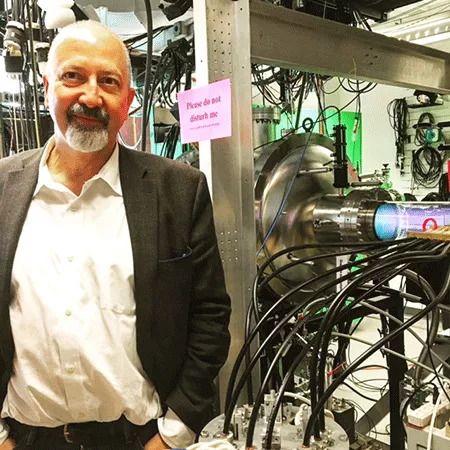New NSF Grant Will Fuel Physicist Michael Brown's Study of Plasma Waves

Morris L. Clothier Professor of Physics Michael Brown with the Swarthmore Spheromak Experiment machine he designed and created over 20 years ago.
Thanks to a $105,000 National Science Foundation and Department of Energy grant, Morris L. Clothier Professor of Physics Michael Brown will be able to advance his study of how plasma waves, the fourth state of matter found in sun and stars, behave in the wild.
“The grant provides opportunities to use high-tech diagnostics to answer fundamental questions in plasma physics,” says Brown, who is able to tease apart the turbulent characteristics of hot, magnetically-dynamic laboratory plasma thanks to the Swarthmore Spheromak Experiment (SSX) machine he designed and created over 20 years ago. The SSX is rare, and the chance for students to participate in such cutting-edge research is also unique. “The SSX lab is one of the few places in the U.S. where undergraduate physicists have access to astrophysically-relevant laboratory plasma," says Brown.
Studying the chaos of the solar system’s solar wind takes place in a large, neat laboratory lined with hundreds of tools and a glowing tube of plasma at center stage. Creating a lab version of the high velocity, turbulent stream of plasma, protons, and electrons streaming from the sun, means Brown must generate plasma turbulence identical to solar wind. While making the turbulence, Brown’s research team will simultaneously measure correlations of magnetic field and density, he says.
“Normally when a physicist wants to study waves and oscillations in some medium, for example water waves or sound waves, they would disturb the medium in a lab at a fixed frequency (say, with a tiny speaker in a gas column), then measure the wave velocity, the wave length. In nature, particularly in turbulent media, there are waves of many frequencies, speeds, and wavelengths all mixed together.”
The grant supports Brown and his colleagues from Bryn Mawr College and Princeton University in applying a technique until recently only used by satellites. In the satellite experiments, two properties of the turbulence are measured in the solar wind. Then researchers review that data to determine if and how the properties are linked. The plasma waves, called "slow waves" and "fast waves," have been studied before, says Brown, and have been observed by satellites in space turbulence.
“We want to see if they exist in our turbulence, too,” he says. “This would help us verify that our high-velocity plasma is very similar to that in the solar wind. In solar wind turbulence, the magnetic field and density are anti-correlated -- when the magnetic field goes up, the density drops,” says Brown. “This points to a particular kind of plasma wave. We’re interested in whether this phenomenon might be a universal aspect of plasma turbulence.”
The new funding also will allow them to buy some "very nice" diagnostics and do experiments both here at Swarthmore and at Bryn Mawr with Assistant Professor of Physics David Schaffner. In addition, Brown says, they have the simulation support of Jason TenBarge, now at Princeton.
Swarthmore physics majors are involved in all aspects of SSX experiments. “We have seniors working on senior theses for honors and preparing presentations for national conferences,” he says. “This year, we have three seniors coming to the American Physical Society conference in Milwaukee in October.” First-year students help in the lab, too.
“As it turns out, NASA’s Parker Solar Probe will be heading into the sun, so for the first time, we will observe solar wind turbulence that's denser and hotter,” says Brown. “With this grant, we should be able to predict what the Parker Solar Probe will see.”
Swarthmore is investing in its vibrant intellectual culture. Learn how at lifechanging.swarthmore.edu.



